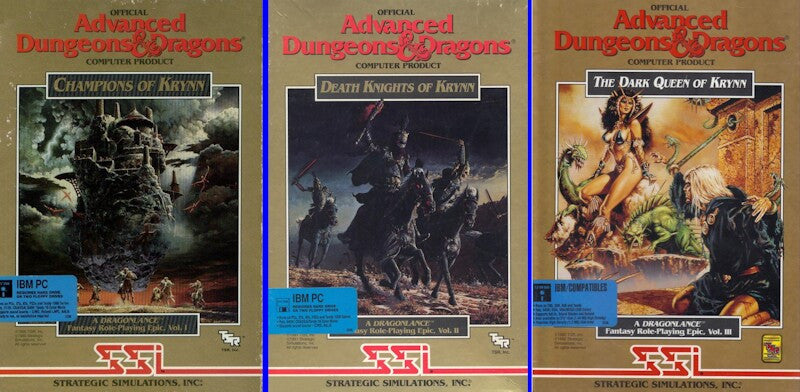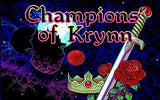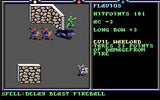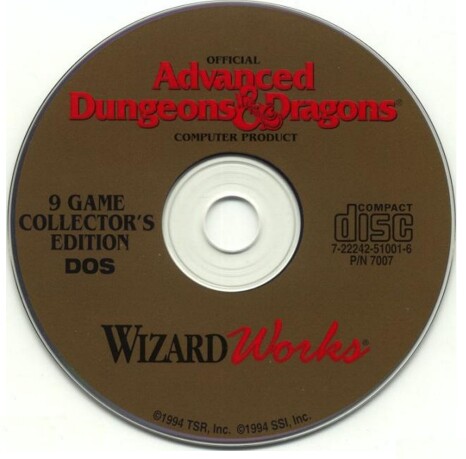
Actual Game
Death Knights of Krynn
|
The Games
The final collection of SSI's legendary Gold Box line was a trilogy commonly referred to as the Krynn Series. These three games saw the Gold Box engine and game world in its best, and final, form. Originally released as three separate games from they were meant to be played in order, by the same party of characters. Shortly after the conclusion of the Gold Box line, SSI released compilations of each complete series so they could be experienced as they were meant to be. This collection contains the three Krynn episodes, namely Champions of Krynn, The Dark Queen of Krynn, and The Dark Queen of Krynn. A review is presented for each.
Chapter 1 -- Champions of Krynn
Champions of Krynn was an SSI Gold Box game to boot up when you did not want to spend weeks on an epic adventure. It was designed to be a quick play and the emphasis is definitely on combat. There are no puzzles to solve or complicated plots to follow. The action is fairly straightforward, although there are some complexities of another kind, ones that expand on the AD&D game universe itself. The ultimate goal in Champions was to broaden the playability as well as the game world of the SSI/TSR Gold Box series. It is interesting to see the evolution in progress.
SSI did not want to change everything because that would alter the base game experience. The goal was refinement so many aspects were left unaltered. For starters, the mechanics and interface are pretty much the same as in Pool of Radiance and Curse of the Azure Bonds. In fact, Krynn bears some resemblance to Pool, as it is a mission-oriented game. However, this adventure takes place in the Dragonlance world and there are some important differences in play, particularly with regard to magic.
In the previous games, you simply had a mage, of whatever alignment, and that was it. Here, magic-users are split out by alignment -- good, neutral, and evil -- and these divisions are not superficial. They have a decided effect on character abilities. For one thing, not all spells are available to all wizards. While some spells are shared, others can only be used by a mage of a particular alignment. Also, a further layer of complexity is added by the influence of the three moons of Krynn on magic. Each branch of magic is governed by one of the moons. Depending on the phase of the moon, the effect can be positive, negative, or nil. Champions was the first attempt to expand the strategic element of combat in the Gold Box series and it was definitely a step in the right direction.
Magic-users aren't the only class that has changed. Clerics have been modified, too. They also are divided into Good, Neutral, and Evil, although in this case, there is no difference in what spells they may use. Instead, it is the choice of which god to serve that confers certain benefits. A cleric of Majere, for example, is able to turn undead as though he were two levels higher, and receives an extra spell. This extra spell is in addition to all others that the cleric may have memorized. Other gods provide bestow different abilities on their clerics.
Changes in the magic system are not the only new feature. Some alterations have been made with regard to character races, as well. In previous games, there were simply Elves and Dwarves. Now the Elves have been split into Silvanesti and Qualinesti, while Dwarves are divided into Hill and Mountain varieties. As far as Elves are concerned, there are no differences between the two types, except that Silvanestis cannot be thieves. With Dwarves, the differences are a bit more marked. Hill Dwarves can be rangers, Mountain Dwarves cannot. Hill Dwarves advance higher as thieves, while Mountain Dwarves can have a higher charisma score.
Paladins are missing from the roster, their place being filled by the Solmanic Knights. The Knights are essentially fighters who receive the ability to cast a few clerical spells at high levels; other-wise they have nothing in common with Paladins. The Knights are divided into three orders: Knights of The Crown, Knights of The Sword, and Knights of The Rose. The last two orders are the ones which receive clerical spells. All player characters start as Knights of the Crown, but can apply for the Sword and Rose orders when they have sufficient experience.
Once your party is created, you begin play at an outpost held by the Solmanic Knights. Here the characters equip themselves, on a somewhat marginal level, as there isn't much for sale. Only a small selection of weapons and armor are available. Enough to get you started, but not much more than that. Better items come later, either gleaned from defeated opponents or purchased in a large town.
When the group is ready, you begin a series of missions assigned by the commandants of the outposts (there is more than one), starting with the investigation of the nearby town of Throtl. The game is, there-fore, somewhat linear in nature. Of course, you can always poke around where you haven't yet been sent, but always save, in case of unpleasant surprises.
Combat is the major activity, and boasts a new feature: the ability to set the difficulty level of the opponents. The levels range from Novice (very easy) to Champion (unbelievably hard), for a total of five. What changing the level does is to modify the number of hitpoints your opponents have. More hitpoints means they are harder to kill, and therefore you get more experience for the battle. Fewer hit-points makes them easier to kill, and you get less experience.
Most of the foes are familiar ones: hobgoblins, minotaurs, evil mages and clerics, fighters, ogres, giants, ghouls, and so on. However, since the game is set in the Dragonlance world, you'd expect to run across some dragons, and you'd be right: dragons, mostly evil, pop up now and then to make your life miserable. More numerous, though, are the Draconians, humanoid dragon men created from the corrupted eggs of good dragons. There are five types, all of them nasty and with special abilities to set your teeth on edge. During the game, several characters from the Dragonlance novels, Caramon, Tanis, and Tasselhoff, make cameo appearances. None of them joins your party for fighting purposes, although Tas is with you through much of the endgame. There are other NPC's you can take on for brief periods, but none of them will stay with you for very long. In general, you are pretty much on your own. Champions was the first Gold Box to award experience points for non-combat activities. It was a nice change to be rewarded for doing something other than fighting and that aspect changed the series from a strategic combat game to more of a role-playing one. Having ones actions rewarded or penalized outside of the fighting makes a combat oriented game seem more immersive and complete. This was a welcome addition to the series, and it remained until the end.
The endgame comes upon you as a surprise, in an attempt to make sure your party is always prepared and maximized. After defeating the extremely nasty Death Knight, Sir Lebaum, you are rushed through a number of sequences that drop you off in Kernen for the showdown with Myrtani. There are some opportunities to rest and renew spells in between, as well as save the game, and in Kernen you can even find a trainer. However, there is no place to have any of the objects you may have picked up along the way identified and no place to buy anything. Ergo, you should be on your toes during the final phase of the game because, while it is fair, it is also unforgiving.
Champions of Krynn was a good game overall, one that started the Gold Box series on the path to maturity. It made sure you knew the value of creating a viable party, with a good ability mix, by challenging you at major plot points. Because Champions is part of a series and characters are meant to be transferred from one installment to the next. To survive the series you must be proficient in the workings of an AD&D world. It was this expectation of knowledge that made the Gold Box installments so enjoyable to hardcore gamers.
Chapter 2 -- Death Knights of Krynn
Like Champions, Death Knights different from the earlier Gold Box installments: It offered a stronger and more coherent plot line, which resulted in a game that players could complete in a shorter time than usual for AD&D games. Death Knights of Krynn picks up the story where Champions left off. In fact, Death Knights lets you import your saved Champions characters, complete with most of their belongings. It's a true sequel, not just the next step in a series of games with a similar theme.
Character races are the same as those in Champions: Hill dwarfs and mountain dwarfs are well-suited as fighters, paladins, thieves, clerics, and others; Silvanesti elves attack well with long swords, short swords, and bows, and make excellent mages or mixed classes; Qualinestri elves are similar to the Silvanesti, but get along better with other races; Kinder are little folk, resistant to magic and capable of taunting opponents into a rage; and humans are strong, and capable of becoming knights.
Character classes, too, are identical to those in Champions,and mixed classes are encouraged. Clerics and mages are the primary magic-users, the difference being that mages must scribe spells into spell books while clerics need no such books. Clerics align themselves with a particular deity, who grants them special abilities. Mages must pay attention to the phases of the three moons in order to make the most of their magic.
Fighters, paladins, and rangers all have particular strengths. Fighters are obviously the best at combat, but they can never learn spells and are susceptible to magic. Paladins can eventually (past the eighth level) learn some cleric spells, and they can heal damage. Rangers can gain druidic spells once past the seventh level, and mage spells past the eighth. They're very effective against giant creatures.
Solamnic knights are the soul of the game. They can belong to one of three orders: the Crown, the Sword, and the Rose. Knights of the Rose are the most prestigious, but they pay performance penalties for the honor. The Krynn stories are all about these super-knights and their special quests — in fact, you can complete neither Champions nor Death Knights without one in the party.
You begin the adventure in the Gargath Outpost. The first character you meet is Sir Karl (from Champions), who descends upon you in undead form and lets you know why you'll want to get involved. Immediately afterwards, you'll find yourself in combat. As with all other AD&D offerings, combat is central, and here you're forced to fight before you can even think about doing something else. If you object to the amount of time spent in combat in AD&D games, you won't be happy with Death Knights, or the entire Gold Box series for that matter. However, the Gold Box combat system is one of the best of its era -- both balanced and tough.
In combat, you can control each character. You can also choose to control just some of them and let the computer take command of the rest. Since magic-users will not cast spells under computer control you should control your spellcasters at all times. You can expect a difficult time defeating many of the monsters you'll face, especially some enemy mages and clerics capable of wiping out your entire party, so it's highly advisable to maintain strict control of your party during the battle. You should gang up on enemy spellcasters first, then whittle down the opposition by concentrating on one or two enemies at a time.
There are 11 locations to explore in this chapter of Krynn where you will encounter a wide variety of foes suited to the world of Dragonlance. In addition, traveling between locations (by means of the overhead map) means encountering other bands of enemies. Fortunately, encounters in Death Knights are less frequent than in Champions or other AD&D games, probably because battles are deadlier than ever. And you will not have the problem of running into endless bands of, say, sewer rats; the game, to its immense credit, only forces you to fight creatures whose defeat really means something.
The overriding theme of Death Knights is the undead. Almost every creature you encounter will either be an undead or be accompanied by an undead. You'll find yourself in battle with zombie giants, zombie mastodons, and zombie minotaurs. Also arrayed against you will be spectral minions, vampires, vodyanoi (which live in water), wights, wraiths, and squidlike wyndlasses. Sivik draconians are tough, magic-resistant, and plentiful. Skeletal giants and skeletal warriors are scattered all over, and the latter are immune to a cleric's ability to repel the undead. Undead orcs, dread wolves, wereboars and weretigers, hellhounds, and undead beasts also abound.
Then there are the dragons. Apart from the undead dragon (which fortunately has no intelligence), Death Knights offers combat against spectral dragons, death dragons, and red, blue, and black dragons. These creatures are deadly, with the ability to breathe fire and lightning bolts, so all heroes who face them must select their attacks wisely. Unfortunately, dragons seem to appear only after the party has already worn itself down (i.e., after a lengthy pursuit), With well-aimed attacks and intelligent conservation of magic spells, they can be defeated.
Like Champions, Death Knights carries a continuous, controlled plot line which logically guides you from one location to the next. But the plot manages to maintain your interest by heightening suspense. For fans of the classic series of Might & Magic, Ultima, or Wizardry, Death Knights will, like Champions, prove to be short and sweet. As a whole Death Knights succeeds very well. By design it does not change the basic Krynn system, but it does add a fascinating chapter to the story.
Chapter 3 -- The Dark Queen of Krynn
Dark Queen of Krynn is the final chapter in the third and final group in the Gold Box collection, generally referred to as the Krynn Series. The Krynn series was similar to the standard Tolkienesque that most fantasy RPG's use, only more of it in the right places by going for epic stories centered around wars between good and evil.
Due to the arogance of the dwellers of the lands, the gods dropped a "fiery mountain" on the capital city of the world's greatest nation and abandoned the mortals to their fate. The survivors struggled their way back to recreate civilization only to have the evil god Takhisis returned. She mutated good dragon hatchlings into the backbone of her army (the most common enemies you encounter in the games). She was eventually defeated and the gods returned to the world in some of TSR's most popular novels and modules ever. The end result was a setting that tended to be a bit darker than the typical forgotten Realm game and it did help distinguish itself.
Dark Queen is the sequel to Death Knights of Krynn. It closes not only the Krynn series but SSI/TSR the Gold Box series itself. This installment takes the then mighty players (remember, you have eight prequels behind you) fresh from their victory over the number two bad guy in Krynn to take on the depraved mastermind -- the Dark Queen herself.
SSI likes to add a subtle distinctiveness to each of the Gold Box chapters, and this installment is no exception. Dark Queen introduces the first undersea sequence.
In Queen, your mission is truly daunting. Your adversaries are extremely powerful and will require all the combat skills you've acquired from the preceeding chapters. This conclusion to the legendary series is not easy. Fare thee well.
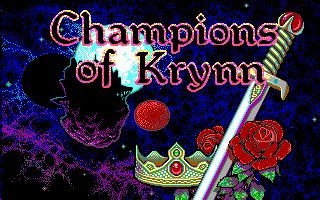
Champions of Krynn
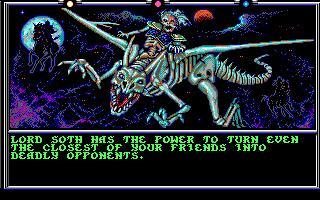
Death Knights of Krynn
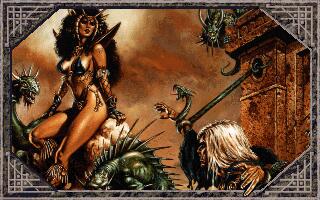
The Dark Queen of Krynn

